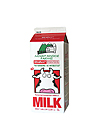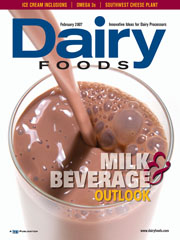
After years of trial and tribulation, the U.S. dairy industry may have finally turned the tide on declining milk sales. Numbers available at press time indicate that overall volume of milk sales for 2006 will likely add up to about 1% growth over 2005.
Industry experts say much of this good news is attributable to innovative products, new sales channels, and growth in foodservice sales. But some say even grocery store gallons are looking up with sales beginning to stabilize.
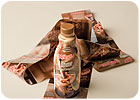
Neilson Dairy, offers a full line of dairy products. It recently introduced a line of shelf stable chocolate milk in HDPE bottles, called Ultimate Chocolate Milk.
Nutrition has become a top political issue, and an organization associated with former president Bill Clinton is offering new voluntary nutritional guidelines for school children on top of the relatively young new food pyramid. Milk from cloned animals may soon be made available for human consumption, and one shudders to think what that might mean for milk’s image.
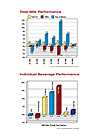
The brave new world of milk has arrived; in fact its arrival might have commenced back in 2004 when McDonald’s began selling milk in plastic bottles. We’ll look at some specifics of how dairy processors are reinventing the category, and we’ll look at what we might see next, right after we crunch the most recent numbers on milk and other beverages.
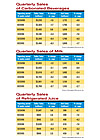
It figures
Sales figures for milk are getting trickier all the time. Information Resource Inc. just made a deal last month with the top dollar store chain in the country, and this is one of the fast growing channels for milk.What we do know, is that through the first three-quarters of 2006, milk sales were up 1.0% by volume, by USDA’s accounting. Total volume was expected to have eclipsed 6.4 billion gallons, the largest volume for a year since 2002.
Looking at the broader beverage arena, the so-called competitive set of beverages is on track for largest total volume ever, an accomplishment repeated each of the last ten years. After quarter three of 2006, the competitive set was 2.7% ahead of 2005.
Milk joins bottled water, RTD teas, and sport drinks with YTD growth through the third quarter, while CSD and fruit drinks are lagging compared to the prior year.
One of the most important measures that has long been a bane of the industry is percapita sales, and there is even some improvement there, with per-capita growth for women aged 25-49 increasing about 8.8% from 2004 to 2005.
Even IRI numbers show that milk is tracking better than juice or carbonated soft drinks in the last six quarters. Keep in mind that the numbers given here do not include Wal-Mart, convenience stores or foodservice.
According to IRI, milk’s unit and dollar sales shrinkage lessened in each quarter from quarter three of 2005 on. Unit sales were up a bit in the most recent period. Meanwhile, CSDs and refrigerated juice were headed in the other direction. The juice part of the equation might bring mixed emotions for dairy processors, but some consolation might be found in the fact that refrigerated tea continues to perform remarkably well.

What's floating the boat
For several years any progress in the milk category has come from places like the impulse cooler and the drive through lane, but almost never from the core-the white gallon jugs sold in the cooler in the back of the Piggly Wiggly or the Safeway. There is evidence, (or at least some opinion) indicating that the good news might now be a bit more widespread.The evidence that foodservice is growing is indisputable. Tom Gallagher, CEO of Dairy Management Inc., says that overall sales of single serve milk are expected to reach a rather dramatic milestone by the end of the year.
“Consumers grabbed a single serve milk 1 billion times in 2006,” Gallagher says. “I can’t think of a better advertisement for milk.”
A portion of those billion bottles were sold by fast food chains thanks in large part to an initiative launched by DMI and McDonalds three years ago. That effort continues to grow, with more chains upgrading their packages and promoting milk sales; and consumers have embraced milk with kid’s meals and burgers.
“I have to report another year of excellent results,” Gallagher notes. “When we talked about this last year, the quick service chains had something like 20,000 to 22,000 stores involved. Right now there are something like 35,000. Now that Burger King and some others like Subway are in it we expect to grow to over 50,000. Just three year ago the food service outlets weren’t promoting milk at all.”
Burger King’s entry is an 8-oz plastic bottle, which has become the standard, but its lowfat white and chocolate milks carry the Hershey’s brand, where most other chains have gone without co-branding.
While DMI helped fund the launch of the program in 2004 by supplementing the cost of in-store promotion, from the start, the retail outlets have spent considerably larger sums on media advertising, and they continue to do so. Gallagher says approximately 300 million lbs of incremental sales of milk in 2006 are the return on investment for the industry.
While single serve continues to grow, along with value added products including organic milk and reformulated milk, gallon jugs of white milk still are losing ground, but perhaps at a slower pace. There is a chance that the statistics related to this core area, and its true performance, are being impacted as jugs are also migrating into less than traditional channels like club stores, mass merchandisers and dollar stores. It may be that the core has redefined itself.
“I don’t think that overall the core volume is losing that much ground,” says, Tom Nagle v.p. of marketing with the International Dairy Foods Assn. “Our core sales are moving with the rest of the food business into alternative channels that we don’t track as well.
“The core volume consumer is perhaps the part of the market that is most attuned to the weight-loss benefit messages that MilkPEP (Milk Processors Education Program), and DMI have gotten behind. We think the impact of that message has brought and will continue to bring a dramatic turnabout in the percentage of women who say they are drinking more milk rather than drinking less.”
Those messages are going into their fourth year, and will continue in 2007, as will a MilkPEP partnership with Curves fitness centers for women-a cap promotion tie-in is planned for later in the year.
What is new in 2007 is Think About Your Drink, a campaign based on a recent report called What America Drinks, which found that the average American gets 22% of his or her calories from high sugar beverages like soft drinks and fruit drinks with little nutritional value.
“The idea is that everyone is more concerned than ever about their food choices, but if they aren’t looking in their glass they may be missing something,” Nagle says.
“It’s a more competitive statement than ever before. It’s a chance for us to say that what we have over here is part of the solution, and what you are drinking over there is part of the problem.”
MilkPEP kicked off the campaign on Jan. 8 in Washington D.C. (and simultaneously in 10 regional markets) to explain the program to the consumer media. The media events were co-sponsored by local processors, with local Dean Foods Companies heavily represented.
Think About Your Drink specifically features in-store promotions, new packaging, an online sweepstakes for consumers, a Teen Photo Challenge for students, and a tie in with the Milk Mustache campaign. MilkPEP believes the findings of the study, combined with the high level of promotions, advertising and public relations will drive more consumers to drink more milk.
The organization is asking individual processors to leverage the publicity and exposure in a number of ways including utilizing the new packaging and label templates and point of sale promotionals, creating links from their own websites to help consumers get more information, and developing a local public relations and marketing program with help from MilkPEP.
By visitingwww.milkpep.orgor calling 800/945-MILK, dairy processors can get more information. A new website is being developed atwww.thinkaboutyourdrink.com. That will allow consumers to analyze their beverage choices, and individual dairies are encouraged to link to it as well.
The Body by Milk Campaign which started in 2006 will continue to reward kids and teens for drinking milk by allowing them to exchange UPC symbols for prizes. In similar fashion, Think About Your Drink will offer online premiums including downloadable workout videos from fitness Guru Kathy Smith.
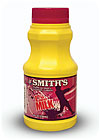
School milk
The industry has been laboring for some years to make improvements in school milk, a segment that has long been the low-bid afterthought arena for most milk processors.DMI’s Gallagher has been a vocal critic of the sometimes shoddy treatment school milk gets, mainly because he is certain that it makes a bad early impression on the categories youngest consumers.
“The white gallon continues to struggle and will struggle for a while until the kids are brought back into the franchise through the single serves,” he says.
There has been considerable progress made in the last few years, despite some intra-industry disagreement over the approach. Plastic bottles, better cartons, improved flavors and more flavors are helping to turn milk into an item of choice in school cafeterias rather than an imperfect complement to the Salisbury steak or tuna surprise.
Smith Dairy of Orrville Ohio, recently gave its school milk a complete makeover, and added its own twist. Smith converted its cartons to 8-oz plastic bottles, and added new flavors. It also incorporated a feature that is a successful part of its core milk line.
“Yellow plastic bottles are kind of a signature for us,” says Penny Baker, director of marketing at Smith Dairy. “We figure if we start introducing the idea of yellow packaging to kids at an early age it will lead to a competitive advantage for us.” Smith is one of several dairies that uses yellow tinted HDPE to protect its milk against light damage, which can deplete vitamin content and alter flavor. Smith may be the first to migrate the feature into school milk.
Through introductory specials, the company will offer the product line to schools with no price increases, but the schools know it will cost them a bit more down the road. In getting schools to buy in, Smith touts studies showing that children believe milk in plastic bottles tastes better, and data showing the improved school milk will lead to more lunch sales, thus allowing schools to receive more reimbursements.
“We are getting a really good response as schools are switching over,” Baker says. “Everyone in the whole organization is behind this and we are working with the schools to educate them on why we are doing this. School milk is real price sensitive, so it’s not without its challenges. But we’ve had to get everyone on board with this, including our drivers. They see the school people everyday.”
Smith is introducing a full line of milk and water in similar packaging. In order to have one line that appeals to all age levels of students, the labels have a sport motif, with athletes in silhouette.
There are a wide variety of flavors and some will rotate in seasonally, including things like orange and cream, and cookies and cream.
“It’s the same formula as our retail milk,” Baker says. “We’re not trying to cut corners.”
Smith installed a new production line at its Orrville plant and the milk products are HTST pasteurized.
Smith may also be recapturing some business in the core, Baker says. Last November was the company’s best November ever in terms of overall milk sales.
Dairy processors who want to upgrade their school milk might want to contact Dairy Management Inc., which now offers a loan/grant program to help offset the cost of the improvements. You can get more information atwww.innovatewithdairy.com.

After school
Milk vending has been a hot topic since MilkPEP launched a milk vending test in 2001. Seeing a dedicated milk vending machine in the school cafeteria has become the norm. But if Roy Warren has his way, milk vending will graduate from school in 2007.Warren, president of Bravo! Brands, North Palm Beach, Fla., is very enthusiastic about a new model Bravo is about to implement through its partner Coca-Cola enterprises.
“I think the real answer (for vending) is to get into 2 million vending machines which is what Coca-Cola owns,” Warren says. “You don’t have to worry about the economics of putting an extra vending machine at a location. And we think that’s a really big opportunity.”
Big enough that Bravo! has developed a special 8-oz. HDPE bottle that will vend from the type of machine Coca-Cola has used historically for 12 oz. cans. The squat-snowman shaped bottles will be used for a variety of Bravo’s own and licensed brands including Slammers, the candy-inspired Mars brand line, and organic milk from Organic Valley Family of Farms. All the milk is shelf stable so that it can be distributed without refrigeration but vended cold.
While flavored milk appears to have lost some of its steam in the supermarkets, Warren says the segment is alive and well. And there is evidence of that from the companies Bravo competes with too.
Nestlé USA of Glendale, Calif. is building a state-of-the-art facility in Indiana for the production of Nesquik in aseptic plastic bottles. Nestlé had previously contracted with Hood, but has since decided its position as the top flavored milk brand in the country was important enough for it to spend more than $300 million on a facility and take the business in house. Like Bravo, Nestlé plans to do more in the way of vending-at ambient temperature.
Last yearDairy Foods’ annual Milk Outlook focused on reformulated milk, and that story continues to evolve. Farmland Dairies, Wallington, N.J., recently introduced a one-two punch by adding some beneficial fatty acid to its reformulated milk. You can read more about developing products like Farmland’s Special Request 1% Plus with Omega-3 in this month’s Omega-3 Q&A on page 36.
Milk has come a long way. And with consumers thinking more about what they eat and drink it’s only just begun.

Sidebar: Going Local
The Farmer’s Cow is a premium milk brand produced and marketed by Connecticut family-owned dairy farms. The Farmer’s Cow was formed in response to consumers’ interest in purchasing fresh, local products naturally produced, without use of synthetic hormones. The milk is currently available in more than 100 grocery stores throughout the state. The Farmer’s Cow milk is sold in half-gallon cartons in whole, 2%, 1% and skim varieties. Chocolate milk and single-serve packaging are under development. The owners of The Farmer’s Cow are active members in The Connecticut Farmland Trust and The Working Lands Alliance who are working to protect and preserve Connecticut farmland.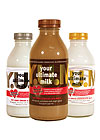
Sidebar: It's Yummy
Y.U.M., is a fat-free milk enriched with natural plant sterols, which are associated with heart health. The name is an acronym for “Your Ultimate Milk.” The product comes packaged in glass quart bottles and in three varieties: Chocolate, White and White Chocolate. Y.U.M. was introduced in the southern United States in September by Promised Land Dairy, San Antonio, Texas. The product is Kosher, and made from the rich milk of Jersey Cows which have not been treated with artificial growth hormones. Plant sterols have been clinically shown to lower low-density ipoprotein (LDL) cholesterol, and products containing them are eligible for the FDA health claim: foods containing at least 0.4g per serving of plant sterols, consumed twice a day with meals for a daily total intake of at least 0.8g, as part of a diet low in saturated fat and cholesterol, may reduce the risk of heart disease.